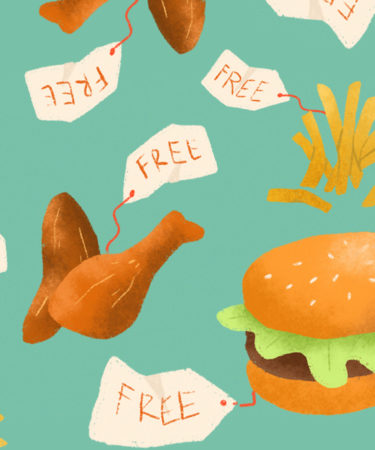In the midst of Covid-19 closures, it’s difficult to imagine long days spent at neighborhood bars. It’s perhaps even more perplexing, particularly for those living in parts of the U.S. where purchasing a food item is mandatory should one wish to buy alcohol at a bar or to go, to imagine being lured in with a promotional free meal. Yet during the early days of urban America, enterprising business owners did exactly that.
We’ve all heard the phrase “there’s no such thing as a free lunch,” a snarky reminder that nothing in life is free. The phrase entered the American vernacular long ago, not as a metaphor, but likely due to the “free” lunch popularized in 19th-century American saloons. While arguably not free, as the purchase of a beverage was required to enjoy the free food, businesses used the tactic to hook customers and keep them drinking like fish.
In “America Walks into A Bar: A Spirited History of Taverns and Saloons,” author Christine Sismondo explains that the free lunch has two “oft-repeated” origin stories. One suggests that the service began in Chicago after saloon owner Joseph “Chesterfield Joe” Mackin tried to drive sales with the promise of one free oyster for every drink. Another more plausible theory points to the New Orleans coffeehouse, barroom, and slave exchange La Bourse de Maspero, or “Maspero’s Exchange,” where, in 1838, proprietors began “handing a plate to anyone who ordered a drink.”
Paul Oswell builds on this theory in his book “New Orleans Historic Hotels,” writing that an Exchange employee by the name of Alvarez may have been responsible for the idea. (Alvarez is referred to in various sources as both a cook and as the assistant bar manager of the Maspero Exchange.) Along with popularizing gumbo, Oswell writes, “he more certainly pioneered the free lunches that, within years, had become a staple of high-class bars the country over.”
According to Sismondo’s theory, the “free lunch” tradition grew popular in areas where manufacturing was booming such as Chicago, Milwaukee, Cleveland, and Pittsburgh. “The [free lunches] that came up around manufacturing [hubs] were specifically designed to get people in on their lunch hour, or immediately after work, because they were cold, hungry, tired, and then keep them there,” she tells VinePair.
The scale and ingenuity of each “lunch” varied from saloon to saloon. Most often, the snacks were salty vittles intended to promote thirst (and thus, drink purchases), with popular low-cost items such as eggs making prominent appearances in hard-boiled, deviled, and pickled forms.
Some saloon “snacks” were more elaborate: In an 1875 New York Times article titled “Free Lunch in the South,” an unknown author (credited as “Our Special Correspondent”) describes a buffet filled with sliced white bread, lettuce salad, oyster soup, potatoes, stewed mutton and tomatoes, and a round of beef weighing nearly 40 pounds.
By the late 1800s, Sismondo says, dueling dives displayed live animals for entertainment; others distributed coins to be redeemed for drinks; and those especially desperate installed urinals in the floor.
Still, as The Times’ “Special Correspondent” poetically describes, these free offerings served most of all as a social equalizer: “A free lunch-counter is a great leveler of classes, and when a man takes up a position before one of them he must give up all hope of appearing either dignified or consequential,” the correspondent writes. “In New Orleans all classes of the people can be seen partaking of these free meals and pushing and scrambling to be helped a second time.”
And so, though the proverbial free lunch may never be free, we can at least take solace in its unifying history: Then, as now, barside snacks serve us as an accompaniment to our drink, and our common and communal desire to keep drinking.
